Schmaltz – How to Render Chicken Fat, and What to Do With It
Confession – I never heard the term “schmaltz” until sometime during adulthood. Growing up on the farm, rendered poultry fat was prized for cooking and baking, but I didn't realize it had a name other than chicken fat, duck fat, goose fat, etc.

Thankfully, I've had a chance to rediscover this wonderful cooking oil, first, with poultry fat from a friend, and more recently, with chicken fat from our first flock of broilers.
What is Schmaltz?
Schmaltz is rendered poultry fat. Currently, it's most commonly made with rendered chicken fat. It can also include duck or goose fat. (Not many geese and ducks on the dinner table in recent years.)
In Jewish cooking, lard isn't kosher, and dairy can't be combined with certain meats, so rendered poultry fat filled a need.
Growing up on the farm, we raised large flocks of ducks and geese for sale and home use. Mom always carefully rendered the fat for use in cooking and baking. Waste not, want not.
How to Make Schmaltz (Rendered Chicken Fat)
Start with clean chicken fat or fatty chicken skins. Sometimes when you butcher, little bits of grit get stuck in with the fat, so make sure to give everything a good rinse.
If you don't have a large amount of poultry fat from butchering, you can save up fat over time and store it in the freezer.
Some butchers also sell chicken fat or fatty skins, depending on your area. (Others might just give you a crazy look when you ask.)
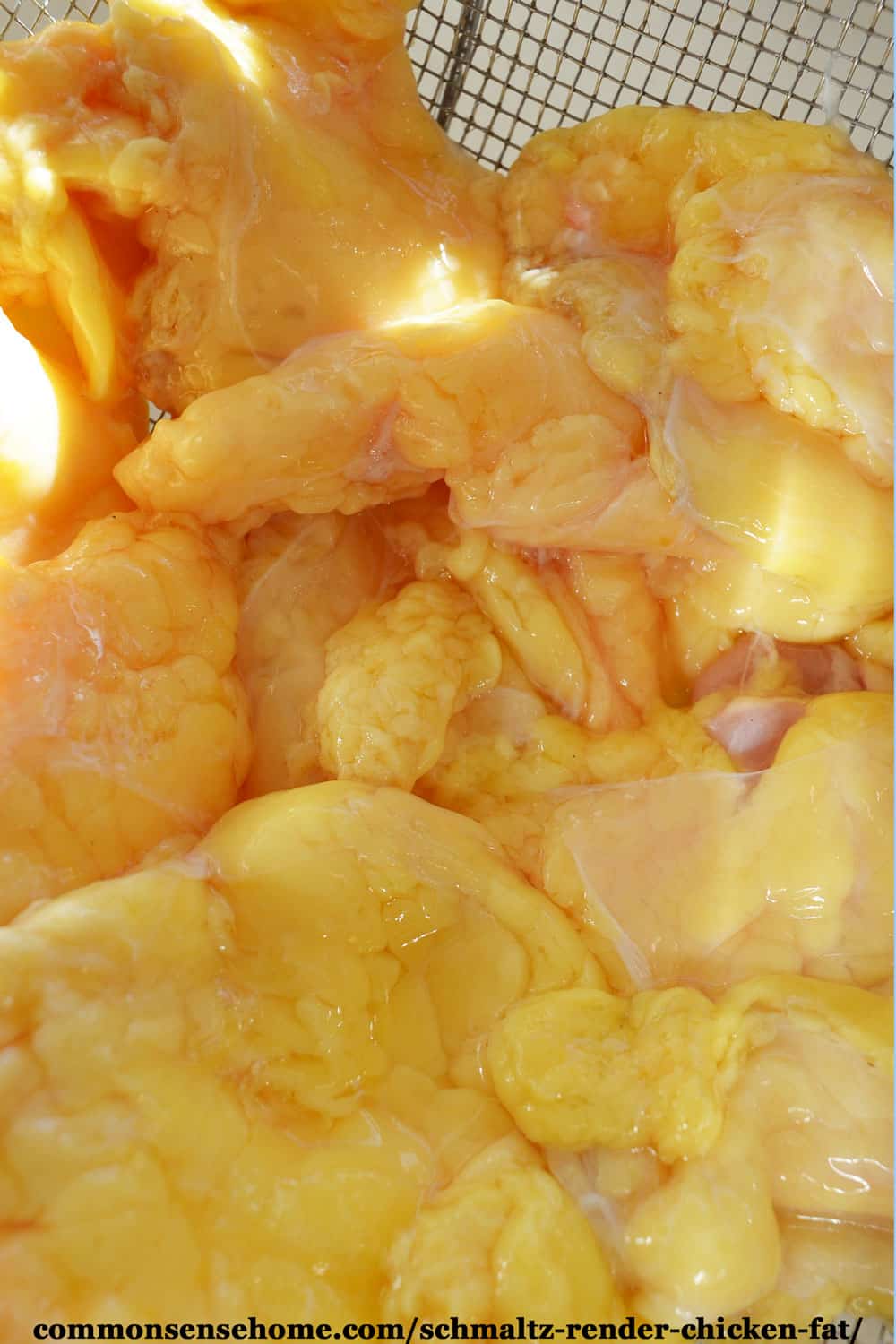
If the fat/skin is in large pieces, cut it into smaller pieces for quicker rendering. It helps if the fat is partially frozen, but a sharp knife will do the job even if it's not frozen.
If you want to make gribenes (crispy skin bits), small pieces are a must.
Place your chicken fat (poultry fat) in a heavy bottomed pan on low heat. (It helps to have a bit of water clinging to the fat to get started.)
Heat gently when you're cooking schmaltz, stirring occasionally, until fat is melted and skin/connective tissue is light brown. You're looking for neutral cooking oil, not charbroiled bird flavor.
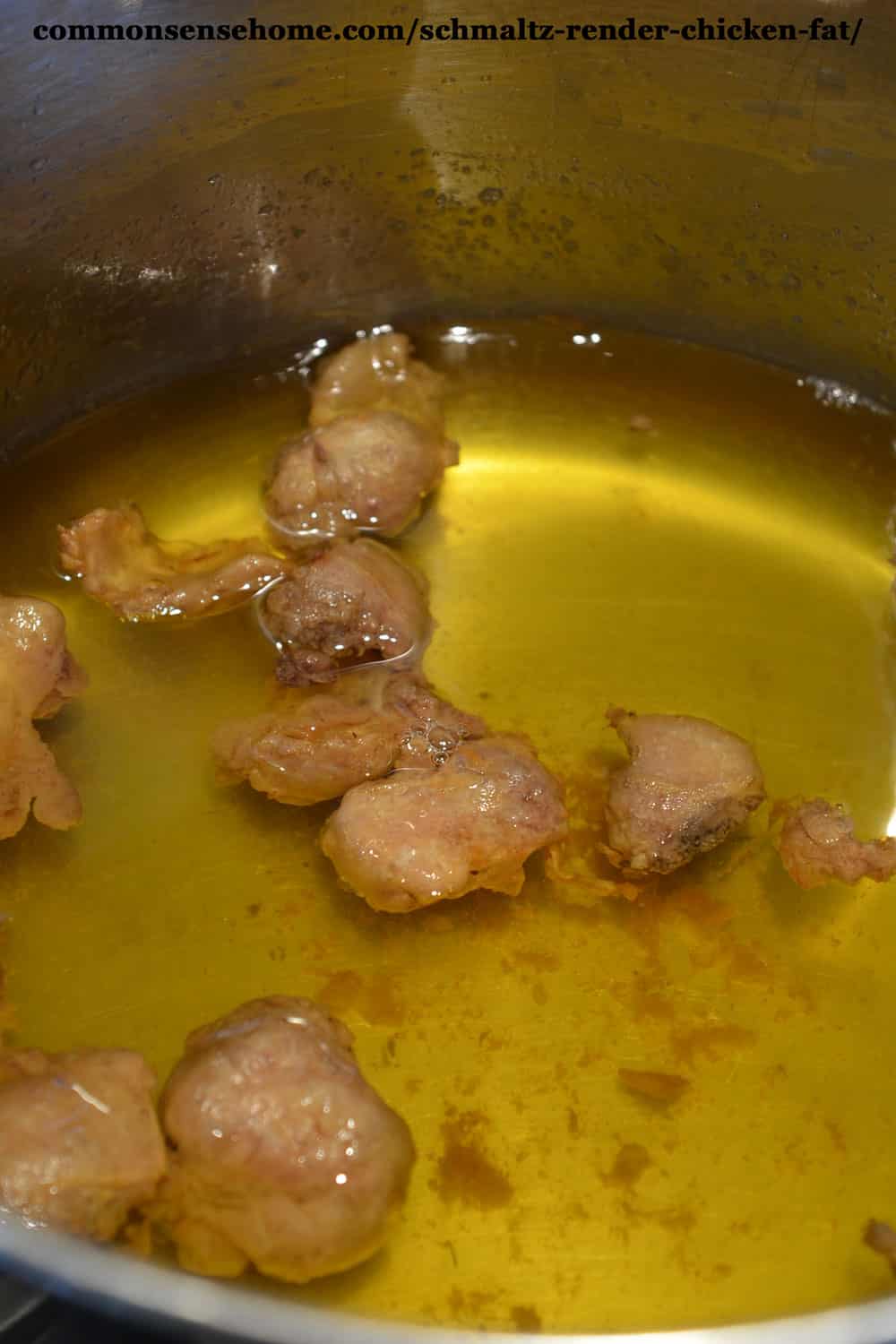
Strain melted fat through a metal mesh strainer. For clearer oil, line with a coffee filter or several layers of cheese cloth. Pour into a glass jar for storage (wide mouth mason jar or peanut butter jars work well).
Cool and refrigerate for up to a week. For longer storage, keep it in the freezer. (Don't forget to label and date your containers.)
To Make Gribenes
The leftovers from the chicken skin and fat can be used to make a dish called gribenes.
To finish the gribenes, return the chunky chicken bits to the pan. Add a healthy portion of chopped onion.
Cook on low heat, stirring frequently, until skin/chicken bits are golden brown and onion is caramelized. Remove from pan and drain on a paper towel.
Alternatively, some people add the onions directly to the fat during the last stage of cooking for an onion flavored schmaltz. Since I like my poultry fat for baking, I keep any onions separate from the fat.
The chicken chunks can be cooked to brown in the chicken fat before straining. Eat the crispy chicken bits while still warm, or refrigerate and use within a few days or freeze.
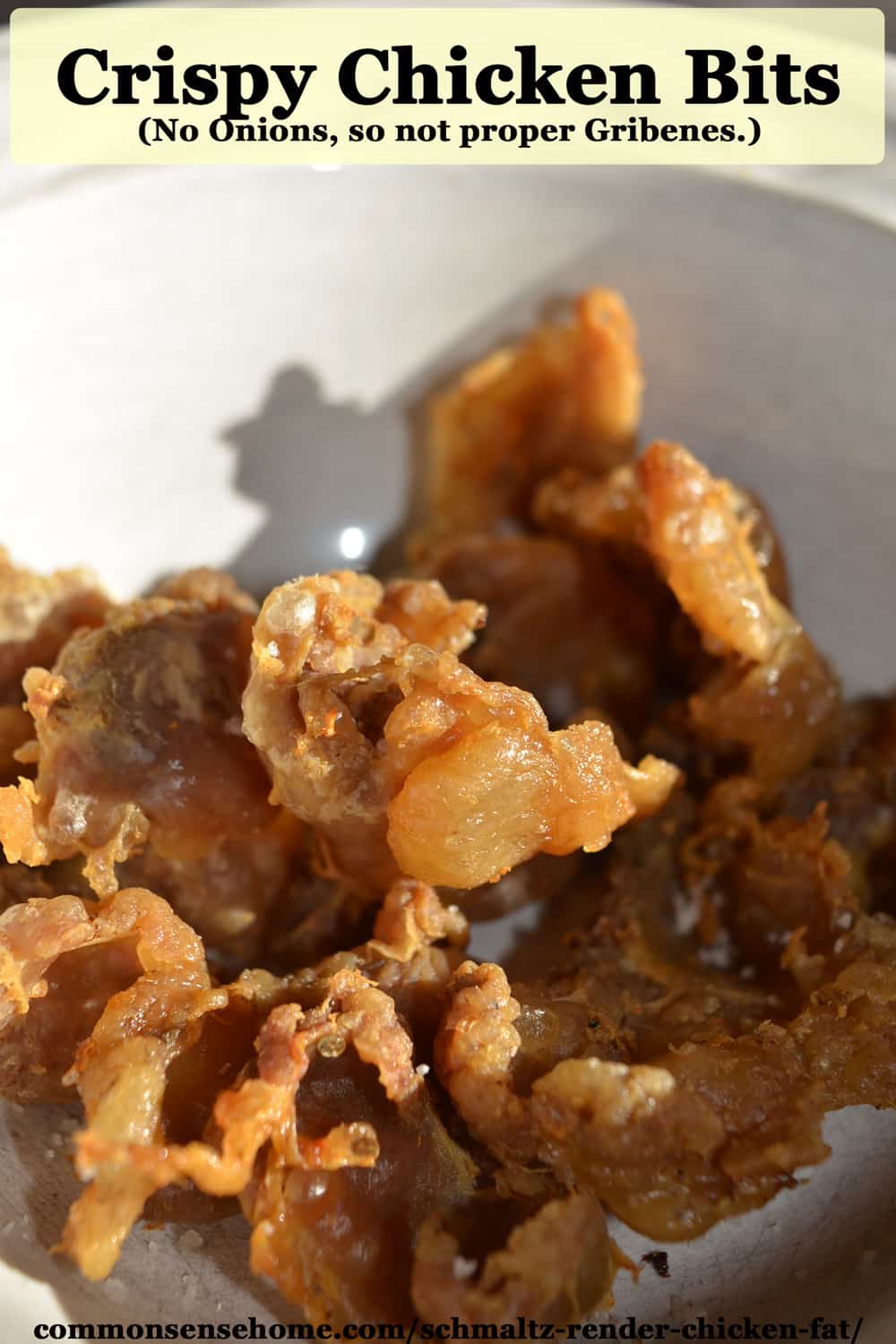
Where Can I Buy Schmaltz?
As mentioned above, you may be able to find raw chicken fat from a variety of sources to make your own schmaltz. (This is likely the most budget friendly option.)
If you're lucky enough to have a Kosher store or deli nearby, they may stock it as well.
It's also available online, such as this 100% Organic Chicken Fat (Schmaltz), Free Range, Kettle Rendered from fatworks. Amazon also stocks rendered duck fat and rendered goose fat.
Is Chicken Fat Healthy?
I hunted and hunted online, but couldn't find any nutrition info specifically focused on chicken fat.
There are studies that indicate that pastured eggs and pastured chicken meat have higher levels of omega 3 fatty acids, more vitamin E and other health benefits, but nothing specifically on fat.
I think it's safe to say that the adage, “You are what you eat” holds true for livestock as well as people.
If you're rendering chicken fat from a factory farm bird raised only on grain with no opportunity to forage, odds are it'll be higher in omega 6 fatty acids. (Enjoy in moderation.) With slow growing, free range poultry, you'll likely see more omega 3 fatty acids.
We found that with our Red Rangers, which had plenty of time outside with fresh grass and other tasty garden bits, and a daily snack of undersized walnuts, their fat was amazingly silky and fine textured.
My youngest, who helped with evisceration, noted that the fat dramatically improved the dry skin on his hands. (He's been working in the garden quite a bit this fall and his hands are quite rough.)
He even requested that I set a little rendered fat aside for him to use as a hand cream. (We did find that the rendered fat doesn't soften quite as well as the raw fat, but it still helps.)
Rendered Chicken Fat Uses
Schmaltz is traditionally used as a spread or for frying (think substitute for butter or lard). I've heard matzo ball soup isn't the real deal without schmaltz.
In our family, mom always reserved the rendered poultry fat for baking, especially holiday baking.
Duck and goose fat was her favorite for kolaches, tea rings and cinnamon rolls. She said the poultry fat kept the rolls soft longer, and I've found it to be true.

It's Not Just About the Fat
We put a lot of care into raising our own chickens, so it matters to me that we use as much of the bird as possible.
We regularly get multiple meals from each bird, starting with roasted chicken, and making soup from the carcass and leftover meat bits.
If I don't make soup right away, I still use the carcass to make homemade broth (including the chicken feet).
Chicken livers make yummy liver spread. This fall I'll be experimenting with ways to prepare the other giblets.
Have you processed your own birds or rendered poultry fat? Do you have questions, comments or suggestions? Leave a comment and share your thoughts.
You may also find useful:
- How to Cook a Beef Tongue
- What to Feed Chickens – Do's and Don'ts of a Healthy Chicken Diet
- Homestead Geese – Easy to Care for Barnyard Protectors and Weed Eaters
Originally published in 2017, last updated in 2020.

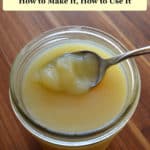
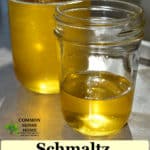
This was extremely interesting. Seems the older I get, the less I like to waste. Finding a way to use the fat off of store-bought chicken is very helpful. Thank you for your post.
Thank you for your kindness. I feel the same way, too, especially with food prices being so high, and wanting to get the most out of the things we raise ourselves, too.
The liquid fat dat gets pored off after cooking chicken in oven is dat suitable for anything OR should I just throw it away,someone said to use wen frying potatoes
Thank you
It’s fine to use leftover saved fat for other cooking, and potatoes in duck or chicken fat are very tasty.
I would store it in the refrigerator between when you cook the chicken and when you use the fat for cooking something else, because bits of chicken left in the fat will cause it to spoil faster.
I’m looking forward to trying this; I’m fortunate to have a 2 large butchers nearby and they are pretty good about providing odds and ends at a good price.
I’ve never cooked with schmaltz, but the best french fries I’ve ever had were actually some I ate in France 35 years ago… they were fried in goose fat. The grocery store shelves were stocked with different animal fats for cooking. (I love grocery shopping in foreign countries when I get the chance.)
Hi there, I really enjoyed your post. Can you tell me please how to use the rendered chicken fat for baking? Do you replace the butter 1 for 1 ?
Any advice would be appreciated. Thanks so much 🙂
Elise
Hi Elise.
It depends on the recipe. In something like bread or cinnamon rolls, I’ll replace one for one. If you wanted to try the schmaltz in something like a cookie, I’d start with replacing only a part of the butter (maybe half?) and see if you like the results. If you’re working with pastry, make sure it’s cold, because it will be softer than butter or lard.
Thank you so much for your reply, I Sure appreciate it. I’m new at this and thankful there are wonderful ladies like you out there willing to help us newbies out. Thx again!
Happy to help.
Thank you so much for this. I had to look harder than I expected for details on using all the parts possible when butchering our chickens (we just slaughtered our first flock last night). Look forward to more posts on the topic!
I’m glad you found the post useful.
Laurie:
I’ve made schmaltz (and gribenes of course) but usually only in small batches from accumulated scraps. I asked a local butcher for some skins and got a 5 pound bag so I’ve been at it for a while. My first batch produced the beautiful golden elixir I was expecting. The second batch seemed cloudy, which I attributed to more moisture in the bottom of the bag, so I poured it into a fat separator. Later the nice golden fat was at the top but when I poured it off I was surprised to find that the liquid at the bottom had congealed in my fairly warm kitchen. Have you ever had this happen?
Not with chicken, but I did get some lard like that from a local butcher. There was a gelatin layer at the bottom. Perfectly safe to eat, but best separated out if possible because it will spoil faster than the fat.
Thanks for the info. After a fundraiser for a Fire Dept, had a lot of chickens left that didn’t get used. We stripped the meat and I asked if I could have the skins and bones. Cooked em down, got about 12 qts of chicken broth left and 1 qt and a half of chicken fat. Will freeze that for future useage….at least 3/4s of it.
Hi. What are your thoughts please, on the fat taken off the chicken stock/broth? ( I was looking for what to do with chicken fat which is why I found your site)
You can skim it and use it for cooking just the same as other fat. The only thing to note is that because it isn’t clarified (unless you skim and cook it down again), it’ll have a shorter shelf life. If I have excess fat on my broth, I’ll skim, keep it refrigerated, and use within a week.
Can you use the fat that is left in the pan from roasting a chicken? Would this be classified as “renderd” fat? What about turkey fat?
You can absolutely use the fat left in the pan from roasting, but be aware that it is likely to contain small meat bits, seasoning, etc. I like to use this fat within a few days for cooking savory dishes, like fried potatoes or veggies or chicken pot pie. Turkey fat or any other poultry fat is fine to use, too. For that matter, any clean animal fat can be used. Waste not, want not. Fats saved from cooking are best refrigerated promptly and used within 2-3 days.
Toni here again……. We were never into margarine or artificial “food”. Hubby’s parents and their siblings (yep, both sides of the family) had major heart issues. His parents came straight from the Ukraine and lived on a farm in Manitoba, then moved to Ontario in the 1940s, still farming and keeping the farm-raised diet. His dad died at age 49. I am very aware of the controversy about fat and heart disease, and even the literature on sugar and cholesterol. And then there is the school of correlation is not causation; Mediterranean vs. Asian diet; on and on. I make pastry with plant oils (coconut, olive) and/or butter. We eat fish twice a week – fresh and salt water. Hubby watches his health and diet, especially since he is also diabetic. He cannot have another bypass or stint. There needs to be a great deal more research on the detriments/benefits of animal fat, but until his health care providers give the okey-dokey there is no way on earth I would give my hubby chicken fat or other suet. Thanks for the good wishes!
Laurie,
This is in response to Toni. First of all I am a nurse with several heart conditions including high cholesterol and early heart failure. My Dad and Grandfather both died before the age of 55. Needless to say I’m high risk. My Cardiologist was always nagging about my cholesterol. I changed my diet dramatically 20+ years ago. One of the biggest thing I changed was the use of margarine. Margarine in any form is basically soft plastic. I read an article that talked about how margarine was made. I switched to butter. I only use butter, margarine hasn’t been in my house for over 20 years. After I did this and it was the only change I made at first my cholesterol levels dropped dramatically, total and LDL (the bad cholesterol), my LDL dropped over 50 points in one year. The only thing I changed was to use butter. So when this cardiologist said see what switching to margarine did, I said no this is what butter did, he couldn’t believe it; I’m sure he didn’t believe me.
I moved from the south to the Midwest and got a new cardiologist, older and wiser. He asked me what fats I was using, I was hesitant to tell him about the butter but he asked me if I was using that “liquid plastic” I said no, he said good I don’t have to convert you back from the dark side. He reinforced what I read years earlier about plastic margarine.
I have done experiments to prove to myself I went back to margarine for 6 months, and guess what ?LDL back up and total cholesterol went up 50+ points, stopped the margarine and went back to butter and my numbers came back down.
Our bodies don’t know what to do with unnatural products; butter, artificial color, artificial sugars. These”foods” stress out our bodies, cause inflammation which leads to disease.
My opinion, and I believe this will be proven, cholesterol is not a number range . When they determine “normal” labs they take the average of a large mixed group of people and tell us this is where your “cholesterol” needs to be. Our bodies make cholesterol, it wants it to be at a certain level. I believe our ancestry has a major impact on our levels. My family is Polish, Russian, Hungarian, all cold regions. I believe our ancestors bodies made this extra “fat” or cholesterol to protect us from the cold and when food sources would be more scarce. I believe that some people will have “high cholesterol” no matter how many Statin drugs they take or margarine they eat.
Whole foods, preferably grown ourselves or by someone who practices organic measures is the best prescription to good health. I think if we went back to eating like our grandparents and great grand parents ate from the “old countries” we would all be healthier. By the way my last heart catheterization was clean, no evidence of plaque, hopefully it will stay that way. I’m 53 so I have already lived one year longer than my Dad.
Laurie spread some of those Grebenes on a slice of your homemade bread, sprinkle a little good salt on top and you will think you died and went to heaven. I have a container in my freezer of chicken fat that needs rendering, yum.
Enjoyed your article as always
Denise
Denise – I ate all the gribenes when they were fresh and hot. 😉
I’m with you on the cholesterol fearmongering and getting back to eating real food. The mother of a close friend of mine (Polish heritage) had high cholesterol and was put on statins and told to eliminate cholesterol from her diet. Her health and memory declined dramatically. One prescription was followed by another and another – most to counteract side effects of the earlier meds. By the time she passed, she couldn’t even recognize most family members. It was heartbreaking.
It’s very unfortunate that most doctors are not paying attention to the most current information about your health and nutrition. Most, including mine, just want to write a prescription.
I have two nieces who are fairly recent nursing grads. Both said they had very little discussion of nutrition in their training.
Hubby has high cholesterol, several heart bypasses and a mechanical aortic valve. I would love to use fat in my baking, but it just seems too scary to give that to him. The current medical opinion is that animal fat increases bad cholesterol. What is a cook to do?
Actually, the tide against animal fat has turned. Recent studies have shown that dietary cholesterol has little impact on blood cholesterol and no link to coronary heart disease. More on cholesterol here – https://commonsensehome.com/naturally-reduce-cholesterol/. Page 2 is about what cholesterol is and how it is used in the body.
Thanks Lauie, but the cardiologist is big on very little animal fat. I will pursue this with him and see what happens.
Toni
Yes, please do check with your doctor. If you truly would like to use animal fat, I encourage you to do more of your own research and see the studies yourself, so you can talk to him with current information.
There is a small but vocal revolution going on to turn the food pyramid upside down. In other words, very little refined sugars/flours and more meat/fat is much better for us.
As someone who feels much better when I don’t partake of refined sugars/flours (I have no underlying medical conditions I just bloat when I eat these things) I happily extol the virtues of fat. We have been conditioned for decades into thinking fat is not good for us when in reality it is exactly the opposite.
I know quite a few people who do much better on plenty of meat and animal fat than they ever did on a carb heavy diet.
We need cholesterol to feed our brain cells. It won’t hurt the heart, contrary to what doctors say. Margarines and hydrogenated products like Crisco are extremely bad for coronary diseases. Do some research and you will agree.
You should educate your self, research Weston A. Price and Wise Traditions. The problem is NOT cholesterol.
There is a bit of information in a book titled, ” Nourishing Traditions” which I found very helpful. It is an excellent resource.
Yes, Nourishing Traditions is a good book. It changed the way I looked at food.
This was very interesting. I don’t have chickens or a farm but maybe one day!
We started with fat from the neighbors the first time we did this. You might be able to find a farmers market vendor or other local grower who would be willing to set you up.